The United States and NATO (NATO, North Atlantic Treaty Organization) also confirmed that North Korea sent troops to the war between Russia and Ukraine. Currently, about 3,000 North Korean troops have moved to Russia, and the number is expected to increase to more than 10,000 by December. Ukraine predicted that North Korean troops would be deployed into combat as early as the 27th.
Video released on the 22nd by the Russian independent media organization ‘Astra’. It is said to be the scene where North Korean troops arrived at the base of Unit 44980 under the 127th Motor Rifle Division in Vladivostok, Russia. Telegram channel capture = Union
In particular, it was assessed that most of the North Korean soldiers dispatched were in their teens or twenties who had just entered the military. This is why there is criticism that Kim Jong-un is selling young teenagers as cannon fodder to protect his regime.
However, this is not the first time North Korea has intervened in another country’s war. North Korea dispatched military advisors overseas in the 1970s. He also participated in the Vietnam War and the Middle East War. However, this is the first time that a large-scale ground force has been sent.
Sergeant Oh Kyung-pil’s overseas experience in ‘Joint Security Area JSA’
‘Joint Security Area JSA’, released in 2000, is a film about the tragedy that occurred between North and South Korean soldiers in a special space called Panmunjom.
![“North Korea’s troop dispatch is an evil deal”… North Korea’s ‘military diplomacy’ only helped dictatorships [이철재의 밀담] “North Korea’s troop dispatch is an evil deal”… North Korea’s ‘military diplomacy’ only helped dictatorships [이철재의 밀담]](https://pds.joongang.co.kr/news/component/htmlphoto_mmdata/202410/27/3362de97-f310-46ea-885f-35fc671348f8.jpg)
Sergeant Oh Kyung-pil of the North Korean army in ‘Joint Security Area JSA’, played by Song Kang-ho. CJ Entertainment
The film’s main characters, South Korean Army Sergeant Lee Soo-hyuk (Lee Byung-hyun) and North Korean Army Sergeant Oh Gyeong-pil (Song Kang-ho), became friends when Sergeant Lee Soo-hyuk stepped on a landmine in the Demilitarized Zone (DMZ) and was unable to move, when Sergeant Oh Gyeong-pil defused the mine.
The background to Sergeant Oh Kyung-pil’s ability to calmly dismantle landmines is his experience as an overseas military advisor. When he met Swiss Army Major Sophia Chang (Lee Young-ae), a member of the Neutral Nations Supervisory Commission who was investigating the JSA shooting incident, at the hospital, he said this when Major Sophia Chang looked at the scars on his face.
There was a terrorist attack in Libya. An Arab knife grazed past me. In Egypt, landmine fragments were dug up with bayonets.
This was the scene where Sergeant Lee Soo-hyuk first crossed over to the guard post where Sergeant Oh Kyung-pil and North Korean soldier Jeong Woo-jin (Shin Ha-gyun) were working. As Sergeant Lee Soo-hyuk played with the pistol, Sergeant Oh Gyeong-pil said this.
(Oh Kyung-pil) Have you ever cummed on someone?
(Oh Kyeong-pil) I’ve tried it a few times.
Then Jung Woo-jin came to the side and helped.
(Jung Woo-jin) Our sergeant comrade is African and Arab, and has been a military instructor for ten years… .
Director Park Chan-wook later wrote this in his prose collection 『Park Chan-wook’s Montage』.
In fact, there was an ending prepared in which Lee Soo-hyuk (Lee Byung-hun) did not die. Five years after the incident, Soo-hyuk, now a civilian, takes a plane to Nairobi. To meet Gyeong-pil (Song Kang-ho), who has become a military instructor again and is active in Africa… .
North Korean military advisors sent with weapons to third world countries
North Korea believed that in order to complete the revolution against South Korea, it had to strengthen its international revolutionary capabilities and launched an all-out ‘military diplomacy’ targeting the Third World. They attempted to earn foreign currency through arms trading and send military advisors to expand friendly forces in the anti-American and anti-imperialist struggle.
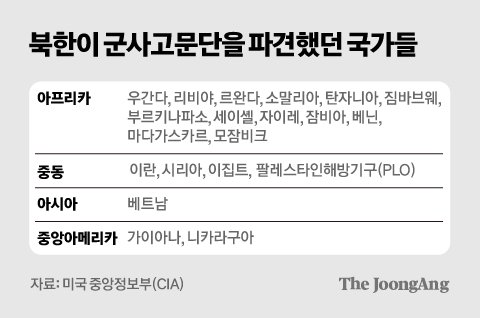
Reporter Kim Kyung-jin
Meanwhile, North Korean military advisory groups were active in several countries in the Middle East and Africa during the 1970s and 1980s during the Kim Il-sung era. Sergeant Oh Kyung-pil, played by Song Kang-ho, would have been one of them.
Declassified in 2009, the U.S. Central Intelligence Agency (CIA)’s August 1984North Korea’s overseas activities‘ According to the report, as of 1983, there were at least 450 North Korean military advisors in more than 20 countries. North Korea’s first overseas military advisory group was sent to Zaire in 1975.
North Korea’s military advisors were tasked with teaching how to use the weapons sold by North Korea and training the presidential guards of the host countries. It is said that dictators such as Robert Mugabe (Zimbabwe) and Milton Obote (Uganda) entrusted North Korea with training their security forces. It appears that the funds earned in this way were used to finance the Kim family’s rule.
Maurice Bishop, who came to power in Grenada, Central America, in a coup d’état in 1979, developed friendships with the Soviet Union and socialist countries to escape diplomatic isolation. Bishop also reached out to North Korea, and the two countries were discussing sending a military advisory group.
On October 25, 1983, the United States invaded Grenada in the name of protecting democracy and protecting its citizens. The name of the operation was ‘Operation Urgent Fury’. At this time, the North Korean military advisory group was not in Grenada. The U.S. and North Korea almost got into a fight.
Mozambique in Africa accepted North Korea’s military advisors in 1982. The Mozambique Special Brigade, which received training from North Korea’s military advisors, was mobilized to suppress the anti-government Mozambican National Resistance Movement (RENAMO).
In Madagascar, a military advisory group of about 50 people, including North Korean Air Force fighter pilots, mechanics, and air traffic controllers, has directly operated the Madagascar Air Force’s four MiG-17s since 1978. The Soviet Union later provided MiG-21s to Madagascar, which were also flown by North Korean military advisers.
In Seychelles, an island nation in the African Indian Ocean, the mercenary group Wild Geese plotted a coup in 1981, but failed. Then, in 1983, Seychelles invited 56 North Korean military advisors to train its troops.
And, as in the conversation between Sergeant Oh Kyung-pil of the ‘Joint Security Area’, North Korea’s military advisory group may not only have manipulated the military of the host country, but may have directly jumped into combat. russia tas communicationAccording to the 2016 civil war in Syria, two North Korean military units, including Cheolma-1 and Cheolma-2, were fighting for government forces. Syrian rebels evaluate North Korean troops as “very dangerous.”
However, it is highly likely that these are military advisory groups rather than combat units. North Korea had already sent fighter pilots in 2013 and a missile-related military advisory group in 2014 to help the Syrian government forces.
North Korea also claimed to be a hotbed of terrorism by training and providing weapons to international terrorist groups such as the PLO and the Red Army.
A North Korean pilot suddenly appeared in the skies of Vietnam in 1966.
North Korea’s first overseas deployment was during the Vietnam War. Starting with non-combat units on September 11, 1964, Korea sent combat units, including two Army divisions and one Marine brigade, to Vietnam (South Vietnam) from October 3, 1965. South Korean troops participated in the Vietnam War until March 23, 1973.
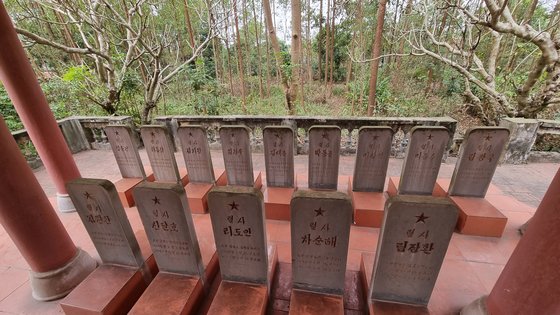
North Korean military cemetery in Pak Dong, northeast of Hanoi, Vietnam. Reporter Jeong Yong-soo
North Korea also responded. As the Vietnam War escalated immediately after the Gulf of Tonkin incident on August 2, 1964, North Korea dispatched engineers to Vietnam (North Vietnam). Since the Korean War, North Korea has been busy digging underground tunnels to avoid air strikes from the U.S. Air Force. The technology was passed on to the Vietnamese.
Also, when South Korea sent combat troops, North Korean psychological warfare units were active in the surrounding area.
In 1965, there were frequent reports in North Korea’s state-run media that the North Korean people had petitioned to go to Vietnam as ‘volunteer troops’. It was a measure to lay the groundwork before entering the war.
On October 19, 1966, Kim Il-sung visited the 203rd Unit of the North Korean Air Force and told fighter pilots that sending troops to Vietnam had great political significance both domestically and internationally. ▶ Faithfully fulfilling noble internationalist obligations ▶ Strengthening the unity of socialist countries ▶ He explained that it was to weaken the US Empire (US imperialism). He also emphasized the need to gain practical experience in preparation for the fight for the South Korean revolution (communist unification).
North Korea’s participation in Vietnam has already been decided. In June of that year, Vietnam requested the deployment of troops, and North Korea appears to have approved this at an emergency meeting of the Political Bureau of the Central Committee of the Workers’ Party of Korea. And from September 24 to 30 of that year, the North Korean military delegation discussed the issue of dispatching troops with North Vietnam and signed an agreement. Kim Il-sung encouraged the dispatched troops on October 19th.
According to Vietnamese records, the North Korean Air Force was dispatched to Vietnam on October 20, 1966, and engaged in its first combat on December 15 of that year. They are said to have been stationed in Vietnam until 1969. There are also claims that it existed until 1974, just before the end of the war.
The size of the North Korean Air Force contingent is one aviation regiment. One regiment had three squadrons, and one squadron had 10 fighter planes. Vietnamese records show that 384 North Korean airmen were dispatched, of which 96 were fighter pilots. However, there is testimony from a North Korean defector that as many as 800 fighter pilots have been to Vietnam, and the late Air Force Colonel Lee Woong-pyeong, also a former North Korean defector, stated that there were a total of 203 North Korean pilots who served in Vietnam.
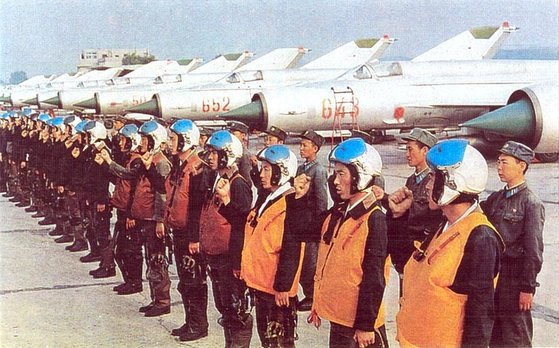
MiG-21 of the North Korean Air Force. North Korea participated in this war in Vietnam and the Middle East with these fighter jets. This outdated fighter is still the mainstay of the North Korean Air Force. Korean Central News Agency
Here were commanders, staff members, mechanics, controllers, logistics support personnel, and medical personnel, as well as political officers and security department personnel unique to the North Korean military. In addition, there would have been agents who recorded and filmed troop deployments and battles, agents who interpreted U.S. military communications, and Vietnamese interpreters. It appears that at least 1,000 people participated in the war.
“We fought actively at first, but then passively.”
The North Korean Air Force was stationed at Noi Bai Airfield, northwest of Hanoi, the capital of Vietnam, and moved to Cap Airfield, northwest of Hanoi, around August 1967. This place was close to Hanoi and the port city of Haiphong. Hanoi and Haiphong were key U.S. air raid targets.
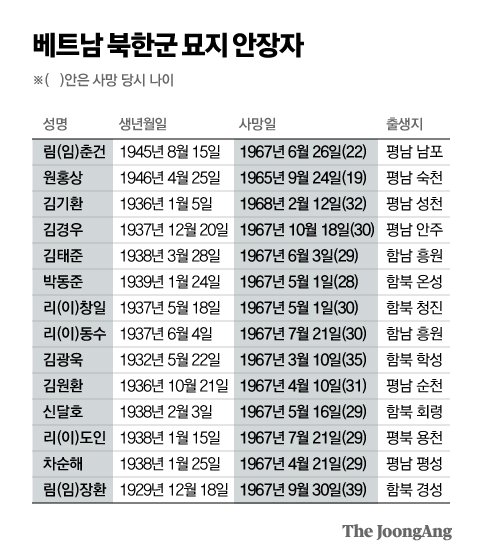
Graphics = Reporter Park Gyeong-min [email protected]
The North Korean Air Force mainly dealt with the U.S. Navy’s aircraft carrier-based aircraft and the U.S. Air Force’s B-52 bombers. According to U.S. military records, eight North Korean Air Force MiG-17s were confirmed on April 19, 1967, and one U.S. military fighter was shot down by the North Korean Air Force on April 24 of that year.
The North Korean Air Force achieved some success by mainly using the tactic of ambushing B-52s and escort aircraft from the air. Woodrow Wilson Center in the United StatesAccording to , between 1967 and 1969, the North Korean Air Force shot down 26 U.S. military planes.
On May 30, 1967, Kim Il-sung sent a telegram congratulating the North Korean Air Force for shooting down about 10 U.S. military planes. On May 28, 1969, eight North Korean Air Force MiG-17s reportedly downed 12 U.S. military F-4 Phantom IIs. To commemorate this, North Korea established the 528th Aviation Regiment.
North Korean air force dead are buried at the cemetery in Pak Dong, northeast of Hanoi. There are a total of 14 North Korean fighter pilot graves here. The tombstone here has the name, birthplace, date of birth, and date of sacrifice written in Korean and Vietnamese. The number of bodies recovered and buried was 14, so including the fallen whose bodies were not actually recovered, the total would have exceeded 14. The late Air Force Colonel Lee Woong-pyeong said he knew 67 people were killed. There is also testimony that there were more than 80 people.
Looking at the tombstones, the deaths were concentrated between March and October 1967 (12 people), and there were no deaths after February 12, 1968 (1 person). “North Korea’s Participation in the Vietnam War” by the Ministry of National Defense’s Military Compilation Research Institute analyzed that the North Korean Air Force actively followed Kim Il-sung’s instructions to “defend Hanoi’s skies like Pyongyang” at the beginning of the war, but may have become passive as time went by.
North Korea hid the participation of its air force in Vietnam, but officially confirmed it on September 18, 2002, when state media reported that a delegation headed by Vice Minister of the People’s Armed Forces Kim Yang-jeom had departed for Vietnam to take over the remains.
It was said that it was a draw with Israel, but there was also the opinion that “many people were killed.”
The North Korean Air Force gained yet another practical combat experience overseas. This time it was in the Middle East.
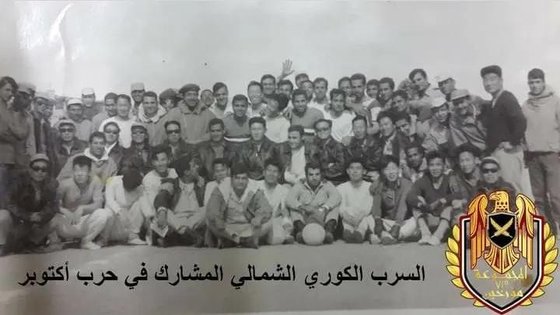
North Korean Air Force fighter pilots and ground personnel dispatched to Egypt took a commemorative photo with the Egyptian Air Force. egyptian air force
Saad El-Shazli, the Egyptian Army’s Chief of Staff, visited North Korea on April 1, 1973 and requested military support from Kim Il-sung. In June of that year, North Korea sent a contingent consisting of 20 fighter pilots, 8 air traffic controllers, 5 interpreters, 3 administrative staff, 1 cook, 1 doctor, and 1 political and military officer to Egypt.
On August 15 of that year (local time), Israel and the United States announced that they had obtained relevant information. Of course, even at this time, North Korea criticized the United States and Israel for completely fabricating the story. Israel also trained Korean interpreters to intercept North Korean pilots’ communications.
The North Korean Air Force contingent was deployed near Cairo, the capital of Egypt, and was in charge of Cairo’s air defense mission.
And on October 6 of that year, Egypt invaded Israel from the south and Syria invaded Israel from the north. It was the beginning of the Fourth Middle East War. On October 18, when the war was in full swing, U.S. Department of Defense spokesman William Beecher said, “Within the last 24 hours, a North Korean Air Force MiG-21 disguised as the Egyptian Air Force engaged in a dogfight (close combat) with an Israeli Air Force fighter jet south of Cairo, with no casualties on either side.” “He said.
The war ended on October 25 of that year. Kim Il-sung later wrote that he was fortunate that the North Korean Air Force completed its mission in the Middle East safely. This meant that there were no casualties.
However, during negotiations with a North Korean general with the surname Han in 1976, Chief of Staff of the United Nations Command John K. He wrote in his autobiography, “Hazardous Duty,” that he was told that “many of them were shot down by Israeli fighter jets due to Sidewinder air-to-air missiles, killing many of them.”
Israel’s recordAccording to , four Israeli Air Force F-4s encountered two Egyptian Air Force MiG-21s during a patrol flight over the Suez Canal on December 6, 1973, after the end of the war. One Egyptian Mig-21 fled, and the remaining one engaged two Israeli F-4s. The Egyptian MiG-21 did not lose in a 2-on-1 air battle with the Israeli F-4 thanks to its clever maneuvering. Two Israeli F-4s fired three AIM-9 Sidewinders, but failed to cause any damage to the Egyptian MiG-21.
The Israeli F-4 squadron was returning to base due to lack of fuel when they witnessed an Egyptian Mig-21 being shot down by an Egyptian surface-to-air missile. It was later revealed that the pilot of the Egyptian Mig-21 was a member of the North Korean Air Force. It is said that it is presumed that he was a pilot who served in Vietnam, judging by his skill in not being defeated even in unfavorable situations.
North Korea attempted to send fighter pilots to Syria, but was unable to achieve its goal due to the end of the war. Washington Institute of AmericaAccording to North Korea, after establishing diplomatic relations with Syria in 1966, it immediately provided tank crews and surface-to-air missile technicians to Syria.
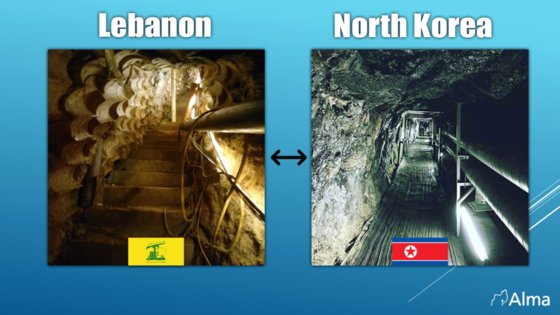
Comparison of Hezbollah tunnels in Lebanon (left) and North Korean tunnels. Israel Alma Institute
Cases of North Korea’s military intervention in the Middle East have also been discovered recently. The Palestinian armed political faction Hamas used the North Korean-made 7 launch tube (RPG-7) when it attacked southern Israel on October 9 last year. Hezbollah, a Lebanese armed faction that is currently at war with Hamas and Israel, learned North Korea’s technology and created its own tunnel network.
North Korean missiles sown in the Middle East, growing into the biggest threat
North Korea gained a lot from its participation in Vietnam and the Middle East.
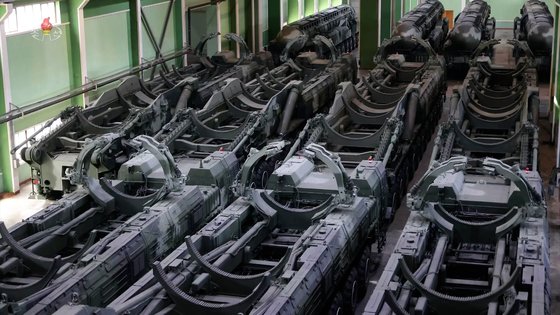
Intercontinental ballistic missile (ICBM) Hwasong-18 launch vehicles produced at an important defense industrial enterprise inspected by Kim Jong-un on the 17th. federation
The North Korean Air Force was able to secure fighter pilots with extensive combat experience through participation in Vietnam. Air combat videos filmed in Vietnam were used as teaching materials. The North Korean Air Force established the 528th Aviation Regiment, focusing on units that participated in the Vietnam War, and deployed it to the domestic base in Hwanghae Province.
The North Korean Air Force established a ‘War Research Institute’ under its headquarters and is deploying not only pilots who served in Vietnam but also pilots who served in the Middle East there to study flight tactics and teach the results to other pilots.
The North Korean Air Force was also able to refine its air guerrilla warfare tactics in Vietnam. It is a concept that applies the guerrilla warfare that Kim Il-sung used in the anti-Japanese armed struggle to aerial warfare. It is a tactic of ambushing at low altitudes to avoid radar, then rapidly rising below enemy planes and then making a surprise attack. On April 15, 1969, the North Korean Air Force shot down the US Navy’s electronic warfare reconnaissance aircraft EC-121 in an air guerrilla battle in the East Sea.
As a token of gratitude, Egypt sent Scud-B short-range ballistic missiles imported from the Soviet Union to North Korea around 1976. North Korea secured ballistic missile technology through reverse engineering, which involves disassembling and analyzing the missile. Following the deployment of the self-produced Scud-B (Hwaseong-5 type, 300 km) in 1986, the longer-range Scud-C (Hwaseong-6 type, 500 km) was deployed in 1992.
As such, the origin of North Korea’s nuclear and missile ballistic missiles, which are the biggest risk factors for the Korean Peninsula, was the Middle East. At this time, North Korea’s ballistic missile technology, which had begun to grow, has now grown to the level of long-range intercontinental ballistic missiles (ICBMs).
1988 CIA reportAccording to , Egypt sent Scud missiles to North Korea in 1983 along with a significant amount of development funds, requesting that it provide ballistic missile technology. Egypt began a ballistic missile program using North Korean technology, ultimately faileddid it Egypt only did good things for North Korea.
Also, thanks to ‘military diplomacy’, North Korea was able to receive support from the third world on the international stage for a while.
“North Korea’s troop dispatch is an evil deal… “You can’t sit back and watch.”
In this way, North Korea frequently sent its troops overseas for its own interests. The countries that welcomed North Korea’s military were all dictatorships or communist countries. And in the process of dispatching troops, the North Korean people were completely alienated, and almost all of the profits went to Mr. Kim.
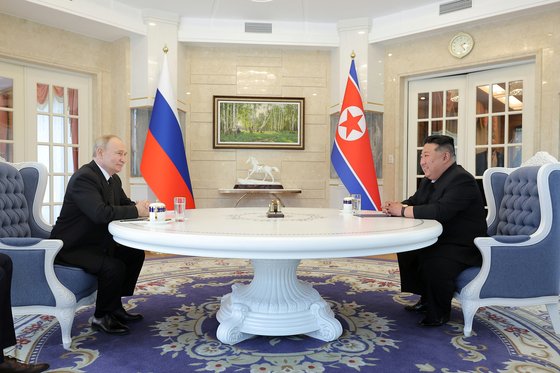
(Pyongyang Rodong Sinmun = News 1) = On the 20th, Rodong Sinmun, the organ of the North Korean Workers’ Party, reported that General Secretary Kim Jong-un and Russian President Vladimir Putin held a private meeting the previous day. The newspaper reported, “We met for two hours and discussed important issues,” and “After the meeting, Comrade Kim Jong-un gave Comrade Putin a gift in commemoration of his visit to our country.” [국내에서만 사용가능. 재배포 금지. DB 금지. For Use Only in the Republic of Korea. Redistribution Prohibited] [email protected]
Then, North Korea set foot in Ukraine this time. Park Yong-han, a senior researcher at the Korea Institute for Defense Analyzes (KIDA), said, “North Korea, which invaded South Korea, and Russia, which invaded Ukraine, joined hands is a typical ‘evil deal.’ If they join forces, it is clear that a shadow of evil will soon be cast on the Korean Peninsula. “You must never sit idly by,” he said.
This is a time when a firm yet wise response from Korea is desperately needed.
Senior Defense Reporter Lee Cheol-jae [email protected]

